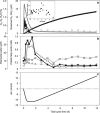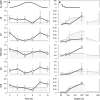Impacts of chemical gradients on microbial community structure
- PMID: 28094795
- PMCID: PMC5363838
- DOI: 10.1038/ismej.2016.175
Impacts of chemical gradients on microbial community structure
Abstract
Succession of redox processes is sometimes assumed to define a basic microbial community structure for ecosystems with oxygen gradients. In this paradigm, aerobic respiration, denitrification, fermentation and sulfate reduction proceed in a thermodynamically determined order, known as the 'redox tower'. Here, we investigated whether redox sorting of microbial processes explains microbial community structure at low-oxygen concentrations. We subjected a diverse microbial community sampled from a coastal marine sediment to 100 days of tidal cycling in a laboratory chemostat. Oxygen gradients (both in space and time) led to the assembly of a microbial community dominated by populations that each performed aerobic and anaerobic metabolism in parallel. This was shown by metagenomics, transcriptomics, proteomics and stable isotope incubations. Effective oxygen consumption combined with the formation of microaggregates sustained the activity of oxygen-sensitive anaerobic enzymes, leading to braiding of unsorted redox processes, within and between populations. Analyses of available metagenomic data sets indicated that the same ecological strategies might also be successful in some natural ecosystems.
Conflict of interest statement
The authors declare no conflict of interest.
Figures





References
-
- Albert DB, Martens CS. (1997). Determination of low-molecular-weight organic acid concentrations in seawater and pore-water samples via HPLC. Mar Chem 56: 27–37.
-
- Billerbeck M, Werner U, Polerecky L, Walpersdorf E, DeBeer D, Huettel M. (2006). Surficial and deep pore water circulation governs spatial and temporal scales of nutrient recycling in intertidal sand flat sediment. Mar Ecol Prog Ser 326: 61–76.
-
- Bordel S. (2010). Steepest entropy increase is justified by information theory. the relations between Ziegler's principle, Onsager's formalism and Prigogine's principle. Phys A Stat Mech Appl 389: 4564–4570.
-
- Canfield DE, Steward FJ, Thamdrup B, De Brabandere L, Dalsgaart T, Delong EF et al. (2010). A cryptic sulfur cycle in oxygen-minimum-zone waters off the Chilean coast. Science 330: 1375–1378. - PubMed
MeSH terms
Substances
Grants and funding
LinkOut - more resources
Full Text Sources
Other Literature Sources

